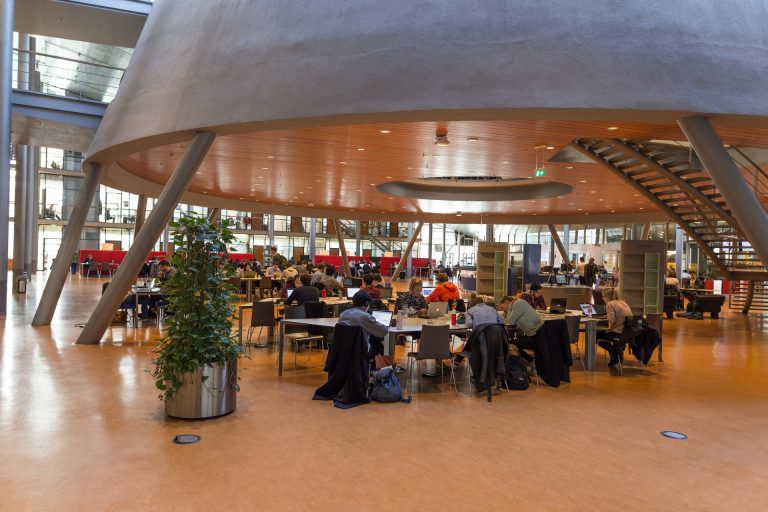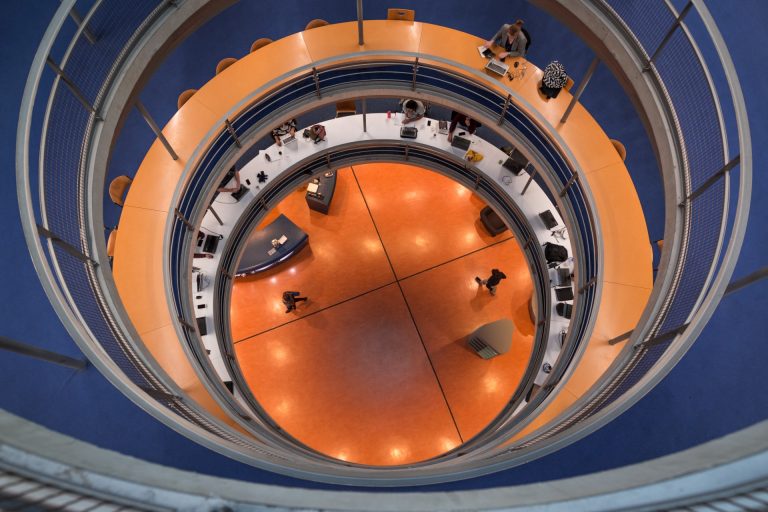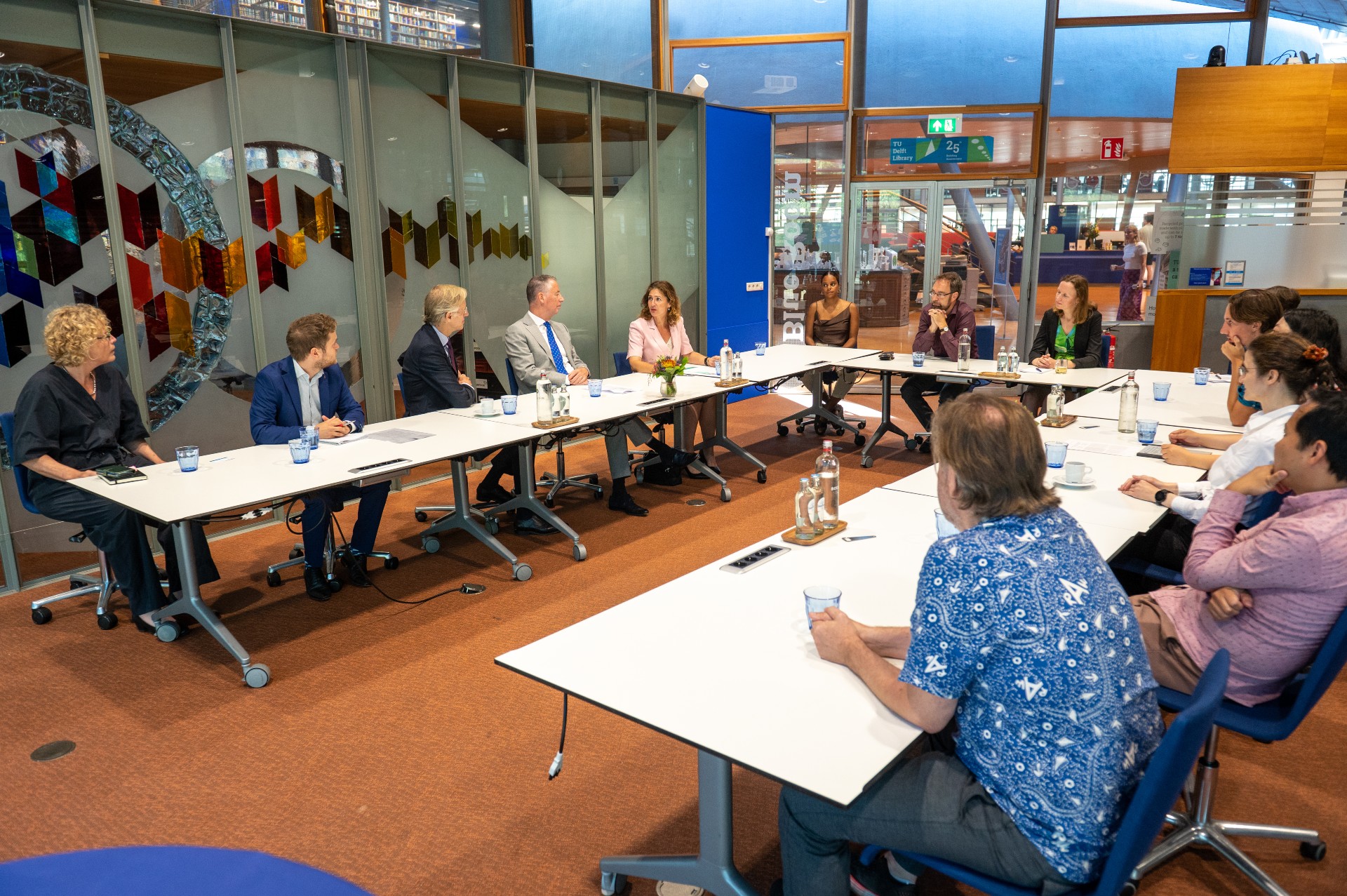Last month outgoing Minister Dijkgraaf had a seat at the table of TU Delft staff involved in open science. It was a closed meeting but Delta spoke to the attendees afterwards.
Outgoing Minister Robbert Dijkgraaf (middle of opposite table) met with TU Delft’s open science pioneers in the library on 7 September. (Photo: TU Delft)
The University of Utrecht and TU Delft are seen as leaders in open science in the Netherlands. It was thus no coincidence that the outgoing Minister of Education, Culture and Science came to TU Delft on 7 September, says Open Science leader Frank van der Hoeven who attended the meeting.
The Minister had previously visited TU Delft for the start of the Regieorgaan Open Science NL (Taskforce for Open Science NL). Regieorgaan Open Science NL is part of the NWO and has a budget of EUR 20 million to speed up the transition to open science.
It looks like open science is going extremely well at TU Delft. This year, 98% of TU Delft’s publications were freely accessible and open access publishing has become the new standard. Researchers sign in agreement in their employment contracts. Further, a revision in copyrights helped move towards almost full open access. The amendment proposed by MP Taverne states that six months after publication, Dutch scientific publications must be publicly accessible in the repository of universities’ libraries.
- Open Access, Open Data, Open Science – see the box below for everything that now falls under open science and what kinds of open access there are.
Frustration
Van der Hoeven explains that it was frustration that started the open science movement in the Netherlands in about 2010. Libraries found it hard to keep paying subscriptions for expensive journals while researchers gave their peer review services free of charge to publishers. There was also a scandal involving a professor (in Dutch) who made up research data. Both developments called for more openness in science: free access to scientific publications and research data.

Open science achievements (Infographic: TU Delft OPEN)
Now, about 13 years later, what is the status of free access to scientific publications and research data? Dijkgraaf discussed this issue on 7 September with five researchers actively involved in the open science movement. What can and must be improved? Delta phoned them afterward to hear their thoughts.
Open science is real science
Dr Junzi Sun, Air Traffic Management researcher, is a keen member of the open science community at TU Delft. He is one of the people that says that ‘open science is real science’ and vice versa. In doing so, he underlines the importance of openness and transparency in the interests of reliable scientific practice.
‘How can you avoid the knowledge that you share being misused?’
The discussion with Dijkgraaf was in Dutch. This prevented Sun from drawing attention to what he calls ‘the battle with publishers’ regarding the sometimes exorbitant amounts of money that authors have to pay to have their articles publicly accessible (see Open Access box). As an alternative, Sun, a network of experts and TU Delft OPEN Publishing set up the Journal of Open Aviation Science. Sun would also like more attention to be paid to the tensions between publishing open access on the one hand, and securing knowledge security on the other. How can you avoid the knowledge that you share being misused for military or commercial purposes while still upholding the openness? Sun would have liked to have discussed this with the Minister.
More than just an article
When Dr Dimitra Dodou published her research on the interaction between humans and robots, she submitted more than just an article. She added an annex with all the data, scripts (computer programmes, Eds.), protocols for the experiments, and demo videos to record the experiments. “Should anyone want to do the experiment, they can take our methodology and replicate it,” she explains.
‘Correcting mistakes is a good thing’
The other side of the openness coin is vulnerability. Someone can find errors in your research data or in its processing. “Of course that’s not nice,” admits Dodou, “but you can learn from your mistakes and correcting them is a good thing.” Dodou also says that being open about research data is also a thing for this generation. These days PhD candidates learn how to make their research data suitable for publication from data managers. Many older professors do not think this is necessary.
Extra work
Dr Anneke Zuiderwijk, Associate Professor at the Faculty Technology, Policy and Management, is a supporter of sharing research data through open data. This year she published an article about the importance of sharing data to enable collaboration between sectors.
‘Prepare for making the information open before even starting the research’
This is not always easy. Researchers need to limit information risks, meet laws about data protection, and make sure that the information is used responsibly. This involves a lot of work which is hardly prioritised. Zuiderwijk believes that to get open access to research data off the ground, this needs to change. One way to do this is to recognise making data available is part of a researcher’s work. “It could be covered in a performance evaluation meeting, for example,” suggests Zuiderwijk. “You can lighten the extra workload by preparing for making the information open before even starting the research.” She previously looked back at the meeting on the TPM website.
Publishing in the same way as developing software
A paradigm shift is occurring, says concert pianist and computer scientist Cynthia Liem (Faculty of Electrical Engineering, Mathematics and Computer Science). Instead of talking about traditional articles, she prefers to talk about ‘knowledge artefacts’. While much is published online, thoughts about publications are still based on printed articles in journals.Liem would like to see that the review process, that is currently largely focused on articles in journals or conferences, is done in smaller steps and look beyond just the text. “I would like to experiment more with this paradigm,” she says, “but I see that many people are not yet ready for this.”
‘Open source means everyone is watching’
Writing articles should be more like developing open source software, she says in an article in IEEE xplore. There she introduces the term ‘knowledge artefact’ whereby the efforts of many are included in a targeted and open way in an article under construction. “There are bugs (errors, Eds.) in most software, but open source means everyone is watching. This avoids getting releases of very unstable programmes, and users can actively help make improvements in the updates by sharing their expertise and experience. It would be good if we could work like this in science too.”
Product design
Two years ago IDE alumnus Jerry de Vos won the James Dyson Award sustainability prize for the plastic scanner that he designed for his graduation project at Integrated Product Design (Faculty of Industrial Design Engineering). The hand scanner distinguishes between different kinds of plastic so that the user can see what can be reused and what not. His Plastic Scanner is now on the Open Hardware website with a link to a page about its further development. De Vos demonstrated his invention at the meeting with Dijkgraaf.
‘You have to produce extremely clear documentation’
De Vos too found that making his design available involved a lot of extra work. “You have to produce extremely clear documentation so that people can use it easily. Another aspect is to communicate clearly and stay focused on the original problem.” De Vos believes, and sees, that idealistic students that want to do something good for society happily take on the extra work. Open hardware gives them the opportunity “to solve a problem together, share knowledge about hardware and software, and move forward as fast as possible”.
Review strike
“When the open science movement started, we wanted to operate more transparently and honestly in science. This largely happened,” observes Programme Leader Frank Van der Hoeven. “But it has not kept the costs manageable. We spend more every year on the publishers. They are powerful companies that do not easily give in. The review – that researchers do free of charge and often in their own time – is the Achilles heel of the publishers. This gives us a strong weapon. I think we should do a review strike to force the publishers to moderate their prices.”
‘Give lower-income countries access to the scientific stage’
Not only does Van der Hoeven wish to reduce the costs for richer universities, but primarily give lower-income countries access to the scientific stage. “I was in Rwanda and Uganda this spring. You should see the situation for universities there. They cannot even free up EUR 2,000 for Article Processing Costs and cannot make deals with large publishers to make journals accessible to their staff.” Thus, Van der Hoeven is a supporter of Diamond Open Access (see box) whereby you do not pay to either read or publish. Publishers such as MIT press act as middlemen to make knowledge sharing as cost efficient as possible.
 Libraries found it hard to keep paying subscriptions for expensive journals while researchers gave their peer review services free of charge to publishers. (Photo: Delta-archive)
Libraries found it hard to keep paying subscriptions for expensive journals while researchers gave their peer review services free of charge to publishers. (Photo: Delta-archive)The new Open Science Programme at TU Delft comprises five projects:
- Open Education – free access to education programmes inspired by open courseware and MOOCs.
- Open Publishing – service provision to reduce the barrier to open publications.
- FAIR Data & Software – service provision to make the use of software and data more transparent. FAIR stands for Findable, Accessible, Interoperable, Reuseable.
- Civic Engagement – using academic communication to increase the involvement of primary and secondary schools in technical academic research (under development).
- Open Hardware – complete documentation online so that other people can produce a device such as a plastic scanner or air quality sensor.
 The TU Delft Library plays a pivotal role in the open science activities at TU Delft. (Photo: Tomas Zwart)
The TU Delft Library plays a pivotal role in the open science activities at TU Delft. (Photo: Tomas Zwart)The similarity among the different forms of open access is free access to academic publications. How this is done varies widely.
- Diamond Open Access – Neither the reader nor the author pay for the publication. This is only available because it is run by academics and other volunteers that put their time into it. (Also called Platinum Open Access)
- Gold Open Access – Offers direct access to published articles. The way in which the costs are calculated vary.
- Green Open Access – Open publication of an article in random journals through a repository, mostly after an embargo period has ended. The Taverne amendment assumes this to be six months.
- Hybrid Open Access – A closed journal gives open access to a particular article if the author pays for it. The Article Processing Charge (APC) costs can range from EUR 2,000 to EUR 10,000.
Do you have a question or comment about this article?
j.w.wassink@tudelft.nl


Comments are closed.